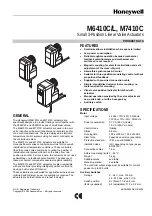
M6410C/L, M7410C Small 3-Position Linear Valve Actuators
EN0B-0096GE51 R0206
2
OPERATION
General
The movement of the electric actuators is produced by a
screw spindle which is driven in both directions by a syn-
chronous motor through a set of gears. A magnetic clutch
limits the torque of the gear assembly and the driving force of
the actuators. The actuators are fixed to the valve body by
means of a coupling ring requiring no tools for mounting. The
actuators are maintenance-free and supplied completely with
a ready-to-wire connecting cable.
MOUNTING POSITION
The actuator may only be mounted beside or above the valve.
Adjust the valve to the correct position before mounting the
actuator.
Fig. 1 Mounting positions
MOUNTING
Before the actuator is fixed to the valve, you must remove the
adjustment cap (Fig. 2). Make sure that the actuator is in the
retract position (factory-supplied position) before fixing the
actuator to the valve body.
Fig. 2 Remove protection cap
The actuator must be mounted by hand. Don't use tools or
additional force because actuator and valve may be
damaged.
Fig. 3 Mounting the actuator
ELECTRIC WIRING OF MOTOR
A fuse with a contact gap of at least 3 mm for each pole must
be fitted with the fixed installation. The fuse rate is max. 2 A.
The electrical installation must comply with the wiring diagram
shown in Fig. 4.
MANUAL OPERATION
The actuators with integrated manual operation (see table
"Versions") feature a hexagonal key hole for manual
operation. For more comfort, an additional knob for manual
adjustment is packed separately. To avoid damaging the
valve, separate the actuator from the power supply before
adjusting manually.
4 mm
Fig. 5 Manual operation




